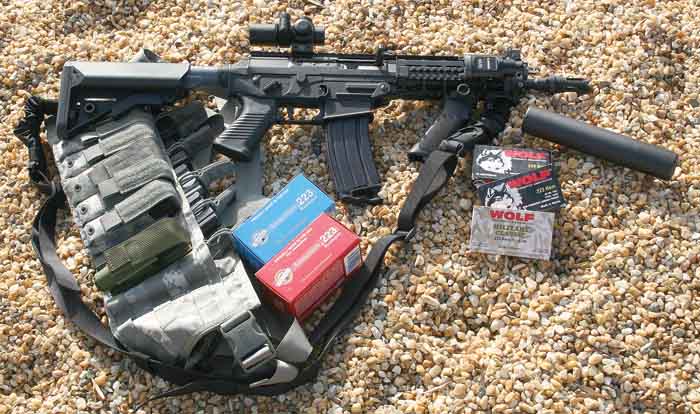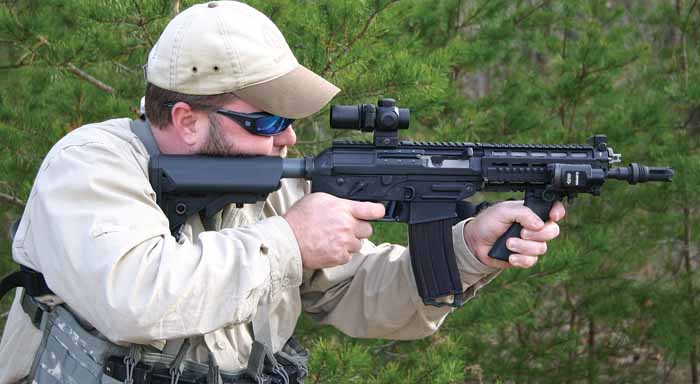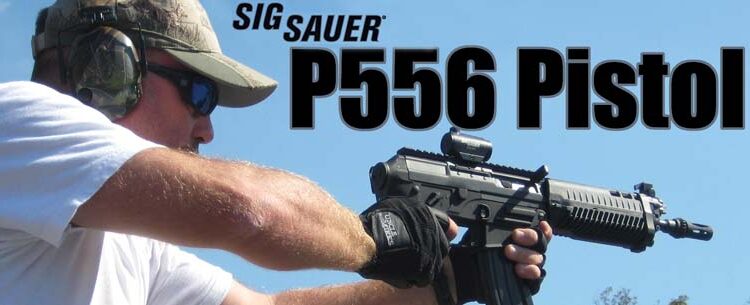By Todd Burgreen
U.S. shooters waited a long time on SIG SAUER’s entry into the civilian “black” rifle market with the SIG556 with the hope of getting a version of the legendary Swiss Army SIG 550 series of rifles. However, SIG designers chose a compromise. The SIG556 trigger housing was altered from the 550-series to accept AR-15 magazines and the forearm furniture is of a different pattern than the SIG550. The proven two-position adjustable gas-piston operating rod system found on the 550 series was kept in the 556’s design. While the SIG556 was designed to accept AR-15/M16 magazines, and the rear stock is interchangeable with AR-15 designs, the SIG556’s operating method is similar to Kalashnikov’s gas-piston operating rod system. The SIG operating rod system is often described as the Porsche of AK designs due to tighter tolerances and better workmanship found in SIG SAUER rifles compared to other manufacturers using the AK as a basis of design. The gas-piston operating system keeps the action cleaner, cooler, and overall more reliable. These are all positive attributes, especially considering the recent rush to create gas-piston ARs for these very same reasons. The SIG SAUER 556 rifle offers a valid option to the AR-15/M16 platform.

The recent introduction of the SIG SAUER P556 Pistol was just the 556 variant many were waiting on with the hope of a simple conversion process turning it into a Short Barrel Rifle (SBR). (Note: Any individual contemplating adding a stock or any other accessories to a weapon designated and sold as a pistol should consult every resource possible about the legalities of doing this. Severe criminal penalties could result if not done properly. SIG Sauer is very adamant in that they will in no way assist or advise in a project of this sort.) Some individuals considering a short-barreled AR-15 have pulled back due to concerns with reliability with the AR-15’s direct gas-impingement operating system combined with barrels under 16 inches. The SIG P556 Pistol now offers a worthwhile alternative.
SIG SAUER chose to use aircraft grade aluminum alloy forgings for the re-designed trigger housing in the 556 compared to the 550-series. This saves a pound of weight in the 556-series compared to the 550-seires. The SIG P556 Pistol is still no lightweight at 6.5 pounds. The SIG P556 Pistol has a 10 inch cold-hammer forged barrel with 1:7 twist. The flash suppressor uses a .5×28 thread pattern. The flash hider that arrived with the P556 Pistol was changed-out with a Yankee Hill Machine (YHM) Phantom Flash Hider that also serves as a quick mount for the very flexible YHM Phantom Suppressor. It was discovered that the YHM Phantom Flash Hider, and also the flash hider originally installed on the P556, prohibited totally removing the gas tube during disassembly. Current P556 models from SIG have a more conventional AR-15 birdcage now installed due to this. It was decided to keep the YHM Phantom installed to maintain the capability of mounting a YHM suppressor when desired. The gas tube can still be accessed for cleaning.

The SIG P556 Pistol comes with a Picatinny rail above the receiver. Front and rear sights that flip-up when needed are provided as standard equipment on the P556 Pistol. These sights are very basic in nature and should only be considered as back-up if your main sight goes down. It is definitely SIG’s intent for the user to install some sort of optic on the SIG P556Pistol. In fact, the SIG P556 Pistol arrives with a SIG SAUER Mini Red Dot sight that mounts on the Picatinny rail.
Many will find the 556’s ability to accommodate a side-folding stock versus the AR-15 inability to do so as added incentive to use it as the starting point to create a SBR versus an AR-15 platform. The SIG P556 Pistol has a threaded plug installed on the rear of the receiver. Upon removing this threaded plug, an AR-15 type stock can be mounted into the rear of the receiver. A Lewis Machine & Tool (LM&T) SOPMOD collapsible buttstock was chosen for the P556 SBR project. The SOPMOD is held in high regard for its solid construction, stable cheekweld, two watertight compartments under the cheek piece, and positive/secure adjustability. The necessary BATF forms, fingerprint cards and proper local LE signatures were acquired and sent to BATF for approval. After the tax stamp was returned permitting turning the SIG P556 Pistol into a 556 SBR, the designating SBR serial number was engraved on the receiver. The LM&T SOPMOD stock was then acquired and installed, and the fun began.
A non-magnified optic was chosen for use with the 556 SBR. Among two of the best available on the market are Trijicon’s Reflex RX30 and Leupold’s 1x14mm Prismatic Sight. Neither are prisoners of battery power. Each is rugged featuring wide fields of view and the ability to use with both eyes open for maximum capability at short range, while retaining the ability to accurately fire at more distant targets.
Ammunition used to evaluate the 556 SBR consisted of Wolf and Black Hills Ammunition (BHA). The 10-inch SIG556 SBR was chronographed compared to 16-inch barreled rifles. The results were approximately 300-350fps lost between the different loads used, which were BHA 77gr MatchKing, BHA 55gr FMJ (remanufactured), Wolf Gold 75gr Match, and Wolf Military Classic 55gr FMJ. (There is a difference in dimensions and loading pressures between 5.56mm and .223 ammunition. An interesting side note resulting from chronographing different loads is that ammunition loaded to 5.56mm specifications showed approximately 200 fps more velocity than loads designated .223 with the same bullet weights.) The overall accuracy of the 556 SBR was surprisingly good at 100 yards considering the non-magnified Leupold Prismatic optic installed for initial accuracy testing with some groups measuring 2.5 inches. To explore the short-barreled SIG’s accuracy, a Mk4 3.5×10 Leupold optic was mounted to the SBR. Groups shrunk down to the 1.5 inch range with the BHA 77gr MatchKing and Wolf Gold 75gr Match loads. The Black Hills and Wolf 55gr FMJ loads averaged 2.5 inch groups. SIG SAUER equips the P556 Pistol with a two-stage trigger, which greatly aids accuracy once accustomed to using. All loads produced more than enough accuracy for a CQB type weapon. The 556 SBR is a legitimate 250-300 yard rifle based on these accuracy levels and ballistics offered by the loads tested even with a 10 inch barrel.
The RX30 Reflex sight with A.R.M.S. (RX30-23) levers allows for quick mounting/dismounting, while still retaining zero. The beauty of the Trijicon Reflex is that it does not require batteries to generate the aiming dot. The RX30 Reflex features dual illumination of fluorescent fiber optics and tritium lamp. The Trijicon Reflex RX30 weighs less than 13 ounces and is designed for hard use by troops in the field made from aluminum with hard coat anodizing. It did not disappoint proving more than capable of withstanding the SIG’s recoil and heat generated from firing multiple magazines during range tests. The Trijicon Reflex’s 6.5 MOA dot aided in acquiring a fast aiming point at CQB ranges. The 6.5 MOA dot in the Trijicon Reflex proved more than capable of hammering steel targets out to 150 yards. For reference, a military silhouette target measures almost 17 MOA at 100 meters. Sighting in approximately 1.5 inches high at 50 yards with the Reflex RX30-23 and Leupold Prismatic corresponds to roughly 3 inches high at 100 yard, zeroed at 200 yards, and 12 inches low at 300 yards.
The Leupold Prismatic weighs 12 ounces and measures 4.5 inches long. The 30mm tube offers 70 MOA of windage and elevation in 1/2 MOA click adjustments. Eye relief is 3 inches for the Prismatic. The Circle Plex reticle is etched into the 1x14mm Prismatic’s glass meaning that batteries are not needed. The Prismatic does have a removable Illumination Module with nine power settings for dealing with all lighting conditions, but again, even if the battery fails, the etched Circle Plex reticle is always present in the Prismatic sight. Leupold distinguishes its etched reticles as offering sharper sight picture versus “fuzzy” red dot patterns. Again, individual users will have to decide what sight works best for them. The Leupold and Trijicon products are good places to start.
Range evaluations of the 556 SBR consisted of an initial reliability test of dumping several magazines in quick succession. After this, the 556 SBR was run through various CQB drills. It is hard to beat the control functions of the AR-15, AK reliability, and SIG ergonomics and accuracy. The SIG 556 SBR’s stout and squat profile aided in fast transitions between multiple targets. The SIG 556 SBR weighs in at over 8.5 pounds with stock, quad-rail, loaded magazine and optics installed. While no lightweight, the 556 SBR’s weight is a good compromise dampening recoil and reducing muzzle climb during rapid strings of fire, yet still allowing for quick target acquisition and ease of carry.
Evaluation of the SIG 556 SBR spanned several months, several evaluators giving their impressions, and numerous range visits with over one-thousand rounds of Black Hills Ammunition and Wolf Ammunition sent downrange without any reliability issues. A quality firearm, ammunition, and magazines are to be credited with this performance. Brownells’ AR-15 magazines were used to supplement the one 30-round magazine that ships with the SIG P556 Pistol. Magazine change drills turned out to be a combination of AR and AK manipulation techniques. The SIG556 SBR does have a bolt hold open feature after the last round is fired, so it was possible to slam a fresh magazine home and hit the bolt hold open lever with your left hand to chamber a round. For the occasion when a magazine was changed without the bolt being held open, the user had to resort to a couple different methods ala AK. Either reaching over or under the rifle with your left hand and work the bolt, tilt the rifle over with the right hand on the pistol grip and work action with left hand, or switch rifle over to left hand and work bolt with right hand. None of these techniques were particularly hard to master, but different from what dyed-in-the-wool AR operators will be accustomed to. The ambidextrous safety found on the SIG556 SBR further simplifies weapon handling.
A browsing of website forums found much initial speculation about fore-end rails designed for the SIG552 fitting on the P556 Pistol. Brugger & Thomet SIG552 rails are not adaptable to the 556 series. However, SIG SAUER introduced a P556 Pistol variant with a quad rail for one of their large distributors who requested this. A SIG SAUER rail was acquired and retrofitted to the P556 Pistol used for this article. The original fore-end was removed along with the collar used to secure the plastic fore-end behind the gas-block. A word of caution is due here to anyone with a P556 Pistol equipped with a quad rail. Do not install any sort of vertical fore-grip on your P556 Pistol. This will run afoul of BATF regulations. Only use the quad rail for lights, lasers, sights, etc., to avoid any legal entanglements. A registered SBR has no such issue regarding adding a foregrip. SIG does not presently plan to offer their quad rail as an add-on accessory, but of course this could always change if enough demand arises. The addition of the quad rail assisted in bringing 556 SBR project to final fruition. The rail enhances the 556 SBR ability to adapt to any role desired by its user.
The SIG P556 Pistol was fired in its original pistol configuration before converting it into a SBR. It is definitely easy to categorize it as a fun firearm, but with only very specific applications in its semiautomatic pistol form. By going thru the process of turning it into a SBR its versatility is multiplied and it transforms into a more serious firearm allowing for more varied use. Yes, some performance is sacrificed with the 10 inch barrel versus 16 inch barrels, but this is the price for any SBR. This is more than compensated for with increased handling and portability, not to mention the cool factr of having something out of the ordinary. Some will question if it is really worth it to go thru the hassle for an SBR? The answer, as with most things related to firearms, is personal preference.
SIG Factory SBRs!
As this issue was going to print, SAR was made aware of a new program from SIG. They are now offering these popular firearms as FACTORY Short Barreled Rifles available for sale to qualified individuals. Since these are manufactured in the United States they can be transferred to individuals who live in locations where short barreled rifles are allowed by law. This is the first time SIG has offered a factory SBR available for individual purchase.
The program was developed from the suggestion of James McLoud of the Manchaster Firing Range in Manchester, NH. After several months of logistical planning the first 100 SIG factory SBRs were manufactured, registered and shipped to McLoud for sale on the open market. SIG set the MAP (minimum advertised price) at $2795.00. Dealers should contact the Manchester Firing Lane for special pricing. These are in stock in numerous configurations and ready for transfer.
We at SAR and very pleased to see a major manufacturer like SIG work with the Class III community in bringing new and innovative products to the market. We are also pleased that James McLoud helped them with this new venture. For specific pricing and availability on the new factory SIG SBRs, please contact the Manchester Firing Lane at (603) 668-9015 or visit them on the web at www.gunsnh.com.
| This article first appeared in Small Arms Review V13N2 (November 2009) |












